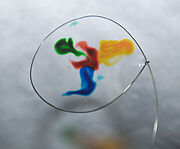
True colors.
Description[]
Colors – good. Food coloring – bad. Many of the food colorings approved by the Food and Drug Administration contain substances thought to be toxic or cause issues such as ADHD and are subsequently banned in other countries. Yet, people have been coloring or otherwise enhancing the palettes of the food for millennia, predating the advent of Red No. 5 and Yellow No. 3 (which sounds even more like sci-fi when you say it out loud in a monotone).
This is how they did it –find something in nature that is the hue that you desire then, extract its color. Here are some tips for capturing some of the rainbow without raining neurological damage upon your children.
Yellow –Use stale tumeric. The spice has a nice bright hue and when its past its prime it has a fairly neutral flavor.
Pink –Raspberry juice stains everything it comes in contact with, including foodstuffs. Mash a handful for a light red tint. For a deeper more saturated color, boil beets and use the resulting crimson water accordingly.
Green –Avocados are pliant and mushy and easily loan their verdant pastel color to frostings and similar applications. For dyes, boil broccoli and other chlorophyll-rich veggies in water to the point of mushiness, remove the vegetables, strain and use the green water that results.
Easter Egg Dye
To make your own Easter Egg dyes, put 3/4 a coup of water in a cup, add a teaspon of vinegar and slowing stir in the pigment of your choice. Once you're satisfied with the hue, gently place your hardboiled egg into the cup and let sit for 2 minutes and remove. Create different colors by blending pigments in the water and vinegar.